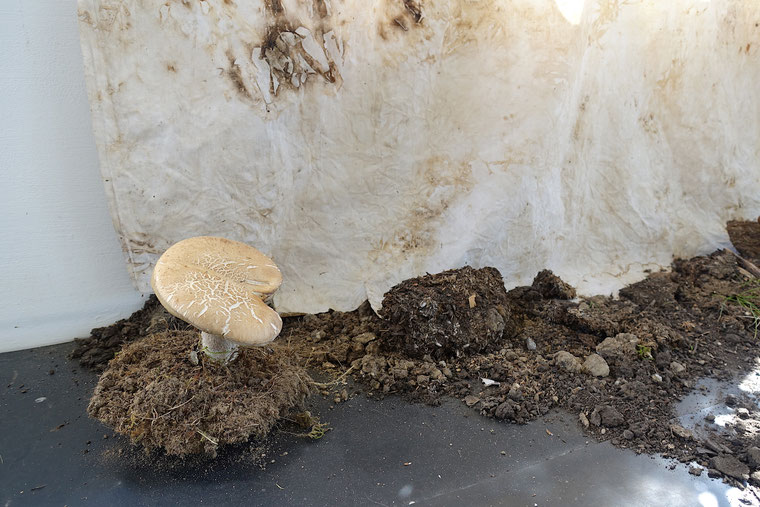
Clothing bales with wasted garments under a compost heap
and brown beech mushrooms
Background:
Fashion is not meant to last. It’s adored only for the moment, nowadays all the more ephemeral. But we hardly think about where it goes once it’s past. The tale of an industry responsible for 10 percent of global carbon emissions is far from chic: globally millions of tons of textiles waste is created each year, almost two- thirds of clothing castoffs are heading directly to dumping grounds and another 10 percent are getting incinerated. Export to the Global South does not only ruin local markets, landfills overseas are heaping up. It can take up to 250 years for synthetic fibres to decompose. The contaminated fantasy needs an urgent metamorphosis.
Fungi: Nature’s decomposers & recyclers
Without fungi and the metamorphic process of decomposing our planet would suffocate covered under layers of dead material. Fungi are the great decomposers and transformers. They digest dead matter and bring it back to life. Fungi are also the great connectors. Underground mycelial networks of intertwined organisms are revealing a new story about the planet’s ability to cooperate and heal itself.
In 2021 & 2022 I'll make further research on the process of decomposing (donated) old clothes & fabrics with fungi & other microbes and organisms in a compost environment.
It evolves from the first experiments I made
with mushrooms and a compost heap during
my residency at 'Kunst in der Natur', 2020
(see further below)
Cotton
becomes
FOOD FOR FUNGI
and other organisms and
micro-organisms in a compost heap
After a few weeks up to some months
natural fibres will almost completely
break down.
Synthetic fibres, such as polyester, leak chemicals and can take up to 250 years to
fully decompose...

Fungal and bacterial filaments in fabric
Detail on decomposed cotton
after just 14 days
-
2020
Below the documentation of
the first research I made
My
Mushroom & Mycelium
drawings
Residency: Kunst in der Natur, am Wachtberg, Waldviertel AT
On July 15th in 2020 I made a stroll through the Wachtberg
forest collecting 28 various fungi.
I wrapped up the different fungi findings
in an old sheet and buried it altogether
under a heap of Wachtberg compost and soil.
14 days later, on July 28th the mushroom flesh
was almost decomposed. Leaving it's traces
and spores, colouring the old bedsheet.
Mycelium worked through the cotton, on it's
organic internet.
A symbiogenetic artwork
in collaboration with various fungi
Just after digging up
& washing off:

July 28th:
Detail of the sheet with fresh fungi & sporangia drawings,
Just washed away rests of earth, fungi & compost.
Here drying on the grass.
result after only 14 days:
The fungi,
and other life in the compost
ate parts of the sheet
Composing
Decomposing
Composing
Decomposing
De-Composing
Below the 28 mushrooms that I collected in the forest around
that were drawing in & working through the white sheet:
I can not name all the mushrooms or fungi yet, also because some started to perish, but I'm studying on it.
Flesh of the earth
Earth made
flesh

Detail of drawings in the corner - right - above

Detail fungi & sporangia below the center

Detail of the sheet, floor left side
humus soil with a St. George's Mushroom

Detail of the sheet with
fungi drawings
floor right side
+
humus soil with a
Boletus mushroom

My mushroom & mycelium drawings in the pavillon with visitors



























